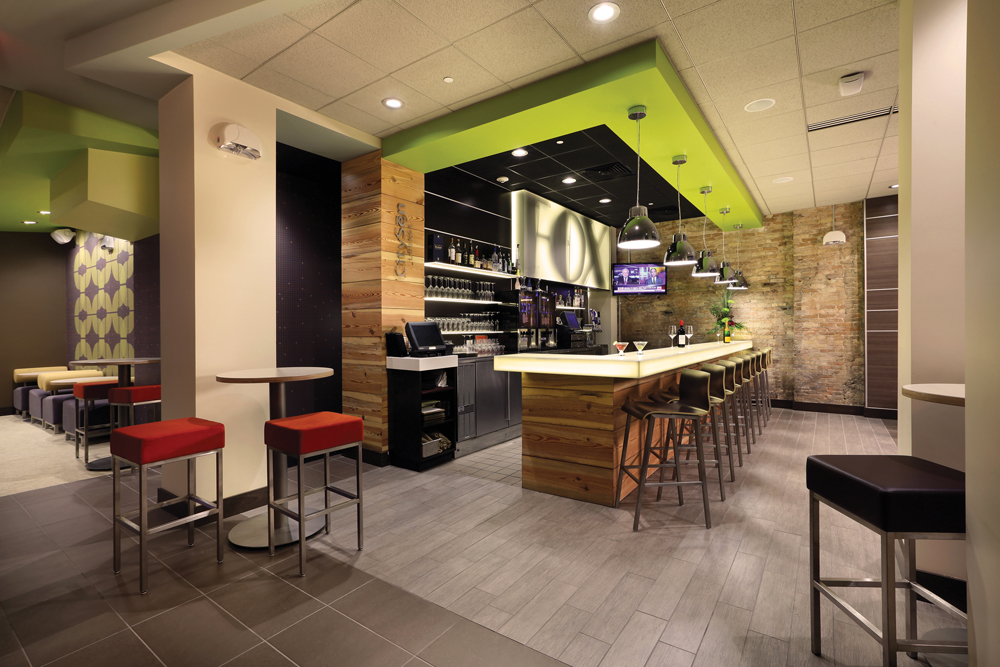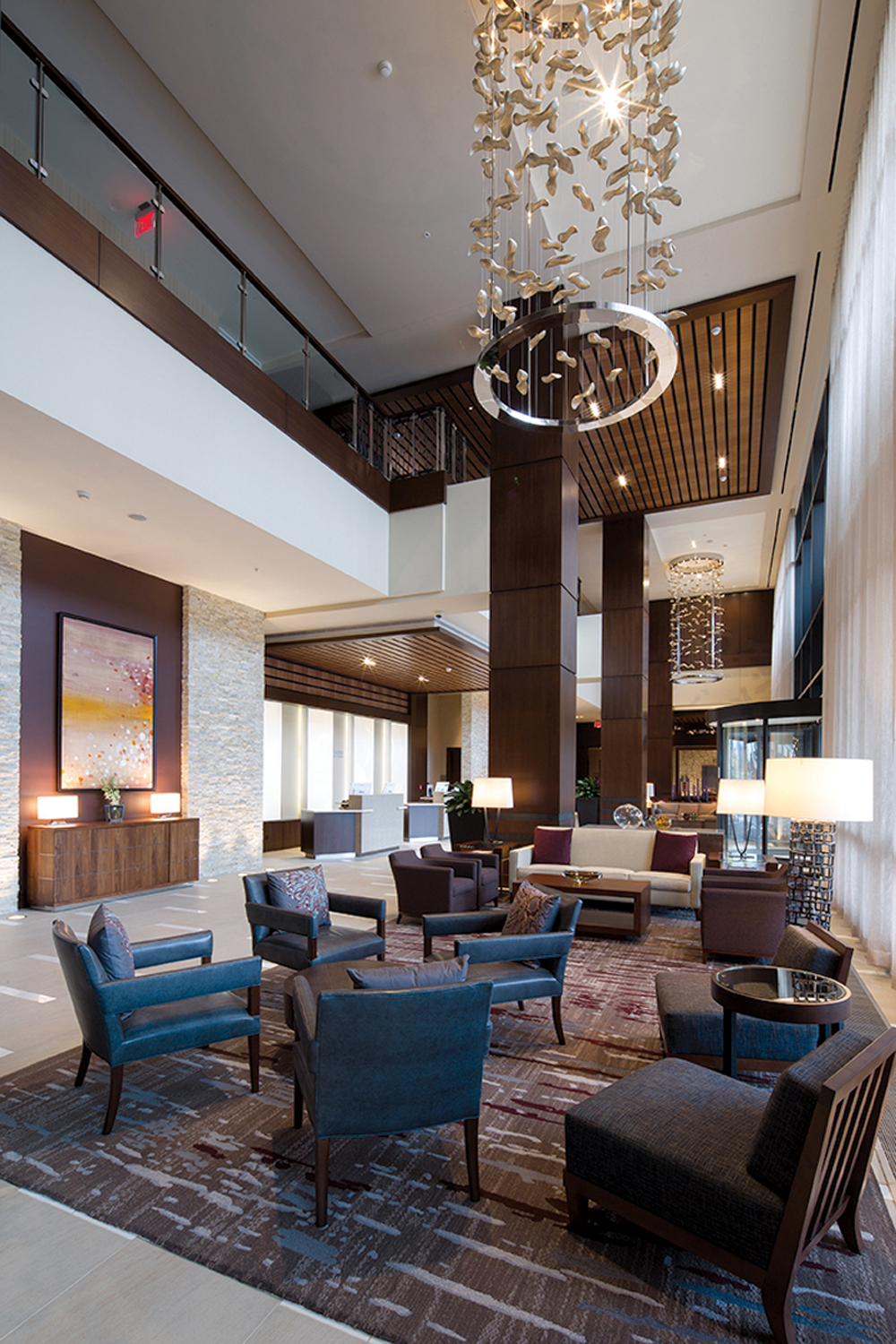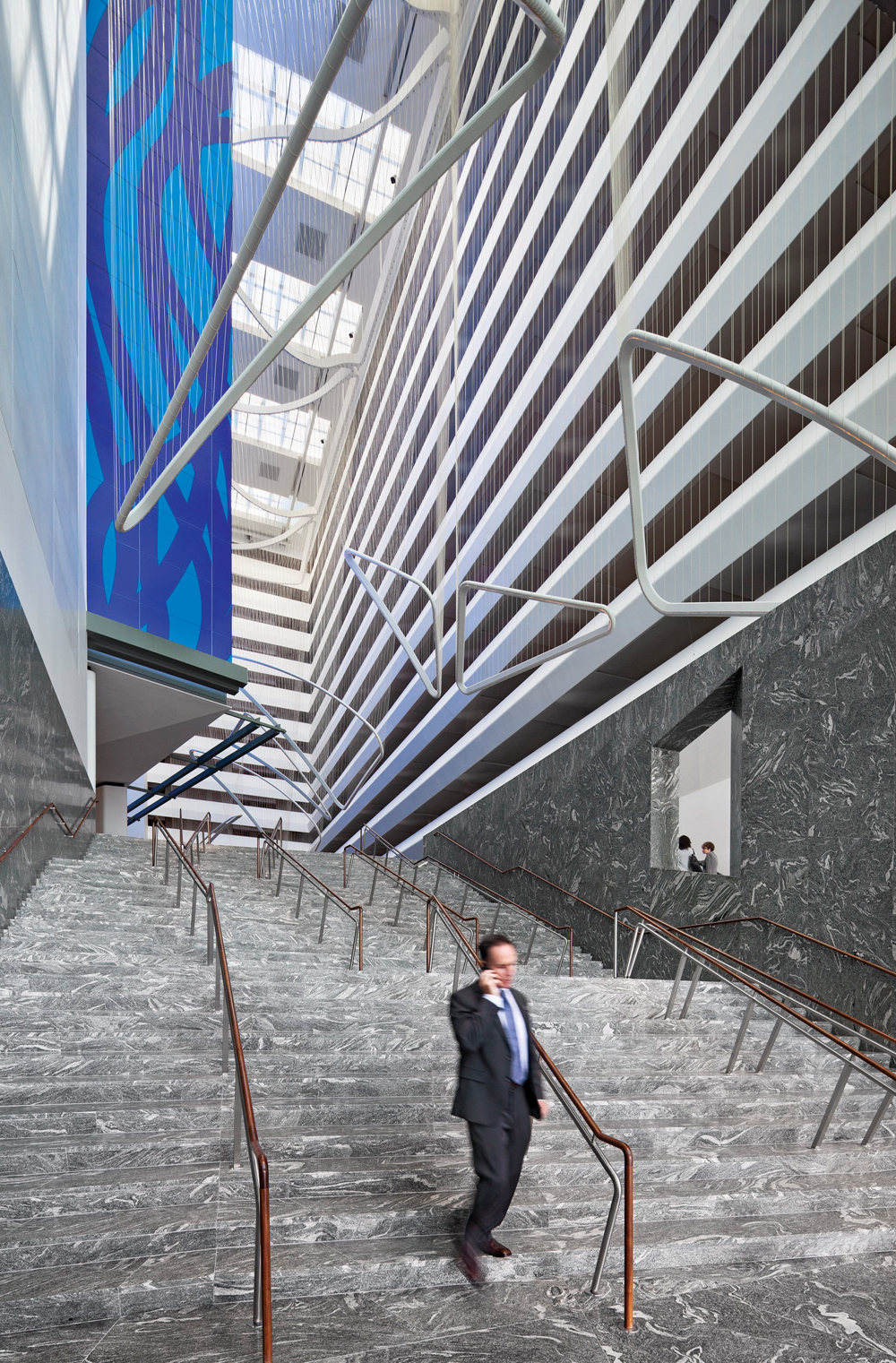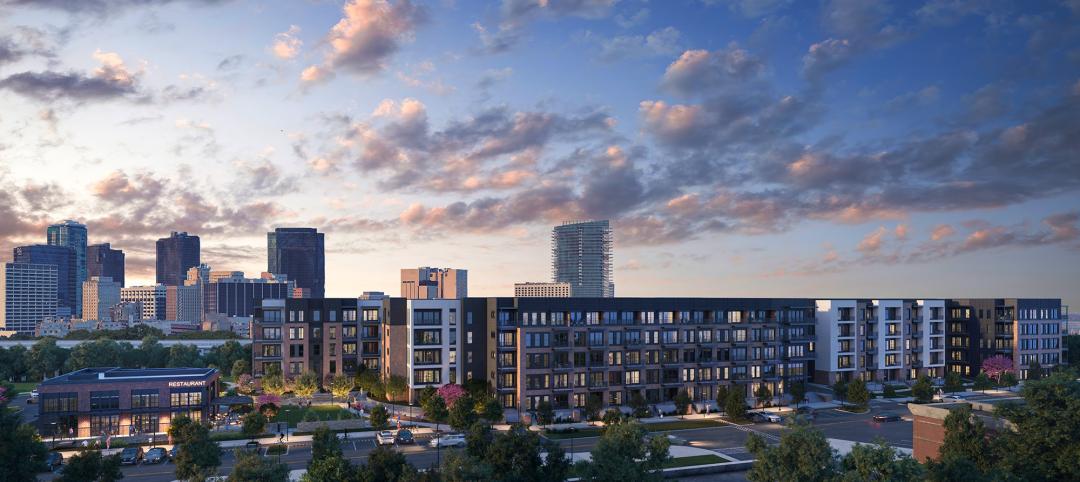There’s more to creating a sustainable hotel than saving water and power by asking guests to reuse their towels. Nevertheless, O&M—from laundry reduction to soap conservation to waste recycling—has long been the major green focus of the hospitality industry, eclipsing sustainable capital projects. Though most lodging chains have adopted sustainability targets, fewer than 100 hotels in the U.S. have achieved LEED Gold or higher to date, including just three Platinums.
A long-awaited version of LEED for Hospitality, which would reflect the unique characteristics of the building type, might encourage more owners and developers to consider certification. But the plan was sidelined as USGBC worked on LEED v4, with hotel-oriented tweaks still contemplated under the NC, EB, and CI systems. Some firms aren’t waiting, and have announced intentions to make their future capital developments greener.
The LEED Volume program, launched in late 2010, aims to grease the wheels by granting precertification of properties once an initial prototype is certified. Marriott was an early adopter, successfully enrolling its Courtyard, TownePlace Suites, and Residence Inn brands. The firm is still working on others, with a stated goal of achieving 300 LEED properties by 2015. Thirteen have hit the mark so far, including seven Golds. Other hospitality-sector Volume participants include Starwood Hotels & Resorts (for the Element brand) and IHG (LEED-EB, for its Green Engage program).
Once the home of Fox Jewelry, this 19th-century building in Grand Rapids, Mich., has been reborn as the boutique, 28-room CityFlats Hotel. Like its new-construction sister property in Holland, Mich., the five-story CityFlats has been certified LEED Gold. Sustainable features include cork flooring, high-efficiency heating and cooling units with occupancy sensors, low-flow plumbing, energy-efficient lighting, and countertops made of Cradle to Cradle–certified glass and concrete. The Building Team: Charter House Innovations (developer), GMB Architecture + Engineering (architect), and GDK Construction (contractor). MICHAEL BUCK / M-BUCK STUDIO
Green marketing to consumers is also gathering steam in the sector. A 2008 survey by Deloitte (http://bit.ly/17389dQ) indicated that business travelers are increasingly interested in sustainable lodging. Forty percent of respondents said they’d be willing to pay a premium for it.
Hotel search engine TripAdvisor (www.tripadvisor.com) quietly rolled out its GreenLeaders program earlier this year, in cooperation with Energy Star, the USGBC, and the United Nations Environment Programme. TripAdvisor vets applicant properties for green O&M but also looks at building design aspects, such as glazing, lighting, HVAC, and landscaping. “Badge” rankings—Bronze, Silver, Gold, and Platinum—are promoted on the TripAdvisor site. Consumers can now select “green” as a search filter, putting sustainability on a par with characteristics like “romantic” and “luxury.” The program is free to participating hotels, which must agree to submit to a third-party audit if questions arise, including consumer feedback regarding inaccurate sustainability claims.
Though they’re less well known to the general public, alternative paths to green hotel branding exist. The main players are Green Key Global (encompassing about 3,000 hotels in the U.S. and Canada); Green Seal, which currently has about 80 participants certified under its GS-33 Standard for Lodging Properties; and Audubon International, with about 150 Green Lodging Program properties concentrated in New York and Florida. Annual participation costs range from $400 to $3,000 per property, involving assessments of O&M as well as the built environment. Some programs require verification by an independent auditor. None are as structure-oriented as LEED.
Alabama’s first LEED Silver hotel, the new 10-story Westin Birmingham, is part of Starwood’s 30/20/20 initiative. The program urges all the company’s properties to reduce energy consumption by 30% and water consumption by 20% by the year 2020. LEED credits related to Sustainable Sites and Indoor Environmental Quality were a focus for the Birmingham project. B&G-MCS A Joint Venture, combining Brasfield & Gorrie and Monumental Contracting Services, created the building in cooperation with Rabun Rasche Rector Reese Architects. Also on the Building Team: The Safaie Landry Partnership (MEP/FP), MBA Structural Engineers (SE/CE), and Bhate Engineering Corp. (geotechnical). © MASON FISCHER PHOTOGRAPHY / COURTESY BRASFIELD & GORRIE
Starwood’s “eco-wise” Element brand, launched in 2008, is another powerful illustration of how seriously the sector is now taking green marketing. The first international property, Element Vaughan Southwest, opened in suburban Toronto this past September, joining 10 U.S. properties. Starwood hopes to roll out more Elements in Europe, North America, and Asia during the coming decade. LEED, minimally at the certified level, will be pursued brand-wide; the flagship Lexington, Mass., property was Starwood’s first Gold-level project. Element’s marketing language combines the traditional “reuse-reuse-recycle” theme with LEED education.
With the AIA Consensus Construction forecast predicting 15% growth in the hospitality sector next year, on top of this year’s 17% increase, investments in green projects may finally be making more sense to decision makers. There’s plenty of room for progress in both the new construction and renovation categories, building on the operational green thinking that’s already pervasive. Stephen Galbreath, AIA, ISHC, LEED AP BD+C, says adaptive reuse of historic properties, an inherently sustainable choice, looks particularly exciting right now.
“Several brands, such as Virgin Hotels and Trump Hotel Collection, have already started to embark on this trend,” says Galbreath, VP for the Commercial Practice Group at RTKL, an ARCADIS company. “Reportedly, Virgin is set to transform an existing Chicago office building, and Trump Hotel Collection is reinventing the Old Post Office building in Washington, D.C. The possibilities of reimagining historic buildings that were never before considered as candidates for hotel development are overwhelming. These are now thought of as viable and sustainable options for hospitality environments.”
The Conrad New York, created through expansion and renovation of an existing Embassy Suites hotel, achieved LEED Gold this year. The 463-suite luxury property also has earned an ISO 14001 certification in environmental management. A green roof and garden provides vegetables for two restaurants, and LEDs account for more than 60% of the hotel lighting. Water-conserving fixtures and sustainable materials contributed to the Gold rating. The Building Team: Kohn Pedersen Fox Associates, Kuwabara Payne McKenna Blumberg, Monica Ponce de Leon Studio, and Deborah Berke Partners (architects), Jill Greaves Design and Remedios Studio (interiors), L’Observatoire International (lighting design), WSP Flack & Kurtz (MEP), Thornton Tomasetti (SE), and F.J. Sciame Construction and Hunter Roberts Construction Group (contractors). MICHAEL MORAN
Related Stories
Industry Research | Jan 23, 2024
Leading economists forecast 4% growth in construction spending for nonresidential buildings in 2024
Spending on nonresidential buildings will see a modest 4% increase in 2024, after increasing by more than 20% last year according to The American Institute of Architects’ latest Consensus Construction Forecast. The pace will slow to just over 1% growth in 2025, a marked difference from the strong performance in 2023.
Construction Costs | Jan 22, 2024
Construction material prices continue to normalize despite ongoing challenges
Gordian’s most recent Quarterly Construction Cost Insights Report for Q4 2023 describes an industry still attempting to recover from the impact of COVID. This was complicated by inflation, weather, and geopolitical factors that resulted in widespread pricing adjustments throughout the construction materials industries.
Hotel Facilities | Jan 22, 2024
U.S. hotel construction is booming, with a record-high 5,964 projects in the pipeline
The hotel construction pipeline hit record project counts at Q4, with the addition of 260 projects and 21,287 rooms over last quarter, according to Lodging Econometrics.
Modular Building | Jan 19, 2024
Virginia is first state to adopt ICC/MBI offsite construction standards
Virginia recently became the first state to adopt International Code Council/Modular Building Institute off-site construction standards.
Mixed-Use | Jan 19, 2024
Trademark secures financing to develop Fort Worth multifamily community
National real estate developer, investor, and operator, Trademark Property Company, has closed on the land and secured the financing for The Vickery, a multifamily-led mixed-use community located on five acres at W. Vickery Boulevard and Hemphill Street overlooking Downtown Fort Worth.
Modular Building | Jan 19, 2024
Building with shipping containers not as eco-friendly as it seems
With millions of shipping containers lying empty at ports around the world, it may seem like repurposing them to construct buildings would be a clear environmental winner. The reality of building with shipping containers is complicated, though, and in many cases isn’t a net-positive for the environment, critics charge, according to a report by NPR's Chloe Veltman.
Sponsored | BD+C University Course | Jan 17, 2024
Waterproofing deep foundations for new construction
This continuing education course, by Walter P Moore's Amos Chan, P.E., BECxP, CxA+BE, covers design considerations for below-grade waterproofing for new construction, the types of below-grade systems available, and specific concerns associated with waterproofing deep foundations.
Sponsored | Performing Arts Centers | Jan 17, 2024
Performance-based facilities for performing arts boost the bottom line
A look at design trends for “budget-wise” performing arts facilities reveals ways in which well-planned and well-built facilities help performers and audiences get the most out of the arts. This continuing education course is worth 1.0 AIA learning unit.
Adaptive Reuse | Jan 12, 2024
Office-to-residential conversions put pressure on curbside management and parking
With many office and commercial buildings being converted to residential use, two important issues—curbside management and parking—are sometimes not given their due attention. Cities need to assess how vehicle storage, bike and bus lanes, and drop-off zones in front of buildings may need to change because of office-to-residential conversions.
MFPRO+ News | Jan 12, 2024
Detroit may tax land more than buildings to spur development of vacant sites
The City of Detroit is considering a revamp of how it taxes property to encourage development of more vacant lots. The land-value tax has rarely been tried in the U.S., but versions of it have been adopted in many other countries.



















